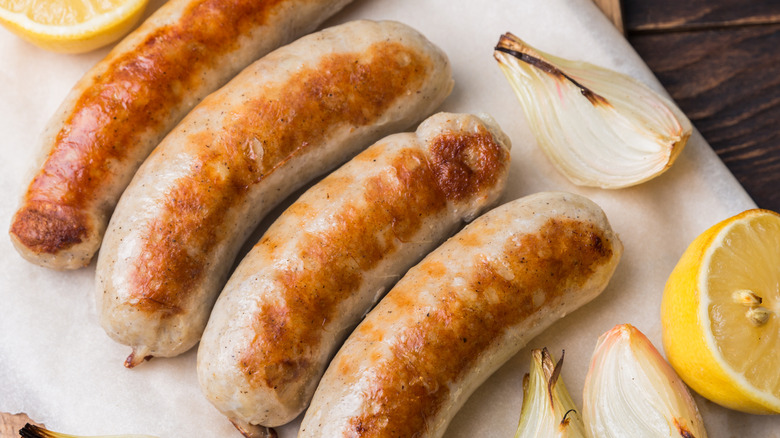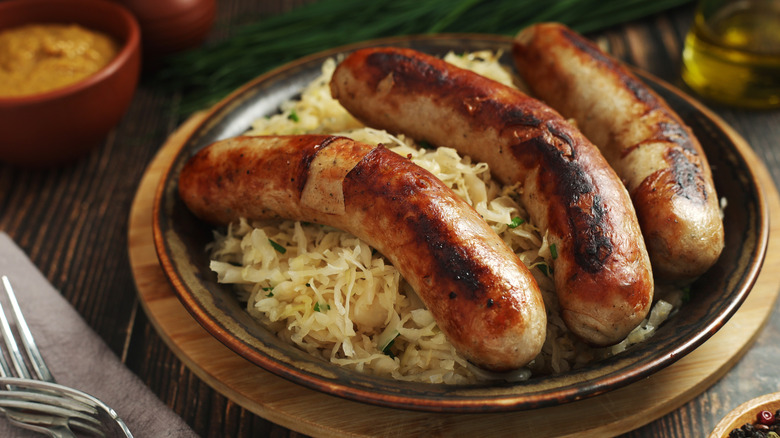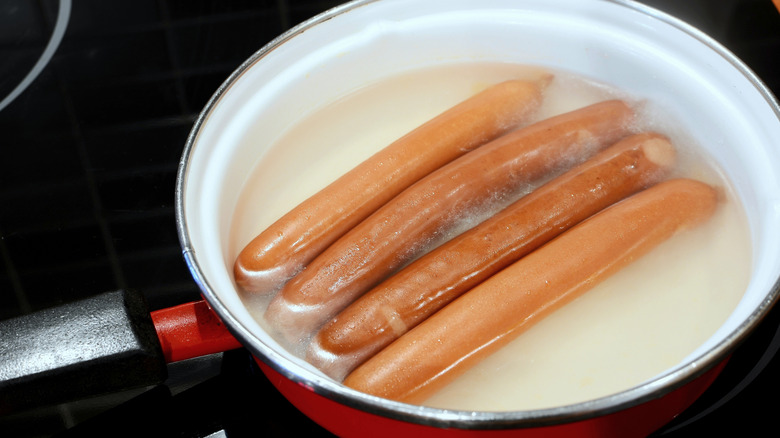Bratwurst Vs Knockwurst: What's The Actual Difference?
You've probably heard of bratwurst, but what about its northern cousin knockwurst? Bratwurst and knockwurst (spelled knackwurst in German) have their fair share of similarities including their country of origin, Germany. They're also both prepared and cooked in a related fashion, both involving stuffing minced meat in a sausage casing before boiling or grilling — or both. Naturally, both fit into various German cuisine quite well from being grilled then served in or with bread with additions like mustard and sauerkraut.
Knockwurst hails from Germany's northern Holstein region, around 70 kilometers north of the port of Hamburg. Meanwhile, bratwurst, of which there are dozens of varieties, stems from Germany's Franconia region within the state of Bavaria. That region is also the proud home of Oktoberfest which, interestingly, mostly takes place in September. Bratwurst came along first and was initially documented in 1313 Nuremberg , around 200 years before knockwurst made its debut up north.
Despite being made similarly, bratwurst contains primarily pork and occasionally beef, while knockwurst is made with ground pork or veal, and commonly made more flavorful with the addition of garlic and paprika. The varying meats and aromatics used also cause the meats to bring different hues, with knockwurst having more of a rich reddish-orange tint. While bratwurst and knockwurst both go well with bread, bratwurst is most commonly found served in a brötchen, or German bread roll. Meanwhile, knockwurst is regionally enjoyed with a slice of white bread and a dollop of tangy mustard.
How to cook knockwurst and bratwurst the German way
If you're wondering about the difference between cooking knockwurst and bratwurst, no need. These versatile sausages can be cooked similarly by being boiled, baked, or grilled. They pair excellently with bread, sauerkraut, all manner of vegetables, dumplings, käsespatzle (a type of German pasta similar to mac and cheese), and even fresher sides like salad or grilled fruit. Wash it down with a bottle or can of beer, and before you know it you'll be singing along to Ein Prosit.
Cooking brat or knock via stove top is mostly intuitive and up to personal preference. Just don't poke holes in the wurst – all the juices will be released and you'll be left with a sad, dry outcome. Just heat a cast iron pan on medium-high heat with a tablespoon or so of oil, plop your sausages in and sear until the wurst reaches a beautiful golden brown color on all sides. Toss in a handful of chopped onions or a splash of beer for extra flavor. Grilling these sausages is a similar feat, serve them with bread and mustard for authenticity.
Try boiling your brat in beer
And if you'd rather skip out on oil, try boiling the brat. Both brat and knockwurst can be boiled in water and beer for about 10 minutes. If you opt for water, parboiling is a reliable method. Simply add the sausages to a pot of water, bring to a boil, then reduce to a simmer for the final ten minutes. Beer will bring more flavor to your wurst. Try adding your chosen wurst, a knob of butter, a few pieces of sliced onion and garlic to a pot of beer.
The sausage should be fully submerged so it might take a few cans depending on how big your pot is. Similar to boiling in water, bring the beer to a boil then quickly reduce to a simmer for the remainder of your cooking time, about ten minutes. Use whatever beer you'd like for this, but a can of something with citrus or malty notes typically translates well to bringing out a tender, deeper flavor to the sausage. Keep it traditional with a German Pilsener or lager.


